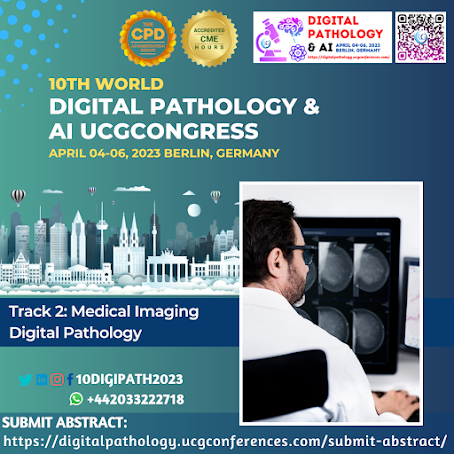Track 2: Medical Imaging Digital Pathology
Track
2: Medical Imaging Digital Pathology
Abstract: Pathology is a medical subspecialty that focuses on disease diagnosis.
Tissue microscopic examination reveals information that allows the pathologist
to make accurate diagnoses and guide therapy. Although the basic process by
which anatomic pathologists make diagnoses has remained relatively unchanged
over the last century, advances in information technology now provide
significant opportunities in image-based diagnostic and research applications.
Pathology has lagged behind other healthcare practices, such as radiology, in
terms of digital adoption. As devices that generate whole slide images become
more practical and affordable, practices will increasingly adopt this
technology, resulting in an explosion of data that will quickly outnumber the
already massive amounts of radiology imaging data. These advancements bring
significant challenges for data management and storage, but they also open up
new avenues for improving patient care by streamlining and standardizing
diagnostic approaches and uncovering disease mechanisms. Commercial diagnostic
systems already include computer-based image analysis, but further advances in
image analysis algorithms are required to fully realize the benefits of digital
pathology in medical discovery and patient care. Pathology image analysis will
progress beyond streamlining diagnostic workflows and reducing interobserver
variability in the coming decades to provide diagnostic assistance, identify
therapeutic targets, and predict patient outcomes and therapeutic responses.
Keywords: Digital Pathology Conference,
conference history.
Introduction: Pathology is primarily concerned with identifying structural anomalies with the naked eye or a microscope, as well as detecting possible relationships with functional disorders of tissues, and thus identifying diseases. Pathology's goal has remained consistent over time, focusing on the analysis and comparison of tissue specimens on specific glass slides. Since optical microscopes were the only available instrumentation for centuries, their use has been critical in this regard [1]. Despite the use of very methodical analysis workflows, the same professional can reach different conclusions about the same specimen at different times. Furthermore, soliciting second opinions is common practice, and specific cases may be included in conferences or external quality assurance programs [2]. As a result, infrastructure for storing and delivering glass slides is required. However, the specimen storage process is costly because it necessitates greater accessibility, cleaning, and protection, which necessitates greater care by specialized staff. In contrast, digital storage and distribution reduces these costs while increasing pathology laboratory throughput.
DICOM: (Digital Imaging and Communications in Medicine)
The DICOM Standard
has been the primary driving force behind the adoption of Picture Archive and
Communication Systems (PACS). DICOM defines not only the storage format for
medical images, but also the communication protocol for exchanging images and
related meta-data among various PACS applications. DICOM objects include a
plethora of meta-data about the image, the acquisition procedure, and the
various stakeholders involved, such as patients, physicians, and institutions.
The standard specifies exactly what information should be included in each
modality, as well as how images should be organized in DICOM files. This
enables DICOM to meet the requirements of medical imaging workflows while also
providing general purpose and vendor image formats.
DICOM was initially
designed as a standard for radiology modalities. Nonetheless, due to the
benefit of aggregating all patient imaging history in the PACS, it has rapidly
expanded its coverage to other medical specialties such as cardiology and
ophthalmology. The addition of the visible light supplement in 1999 marked the
first attempt to incorporate microscopy into DICOM. As stated in the scope of
this supplement, visible light images acquired by endoscopes, microscopes, or
photographic cameras were supported. Endoscopy (ES), Microscopy (GM),
Automated-Stage Microscopy (SM), and Photography were added to the standard as
extensions (XC). Because WSI was still in its early stages, it was not included
in this supplement. As a result, pathologists' needs were not met, and they
continued to work without standard digital imaging end systems. Nonetheless,
the automated stage microscopy modality paved the way for DICOM automated
whole-slide scanners.
Visualization of whole-slide imaging
The arrangement of
image pixel data in the storage data structure has a significant impact on the
performance of the visualization processes. The most basic and widely used
method of storing two-dimensional images is in a single frame/page, with the
image pixels stored in a sequential array. Pixels are typically oriented
horizontally by rows, but they could equally easily be oriented vertically.
However, this organization's WSI screening paradigm has limitations because it
does not provide direct access to 2D sub-regions. As a result, all overlapping
rows in the regions must be loaded completely, which may be impossible due to
the enormous size of WSI. This limitation is illustrated on the left side of
Fig. Because the pixels in red are arranged sequentially, retrieving the green
region necessitates retrieving all of the pixels in red.
Conclusion
As stated in the introduction,
interest in digital and computational pathology has skyrocketed in the last
decade. For example, while two papers with the term computational pathology
were published in 2014, a similar search on PubMed yielded 92 papers in 2021.
While it is difficult to say that the DPC directly caused this increase in
research interest, there is no doubt that the conference did provide some
impetus for the increase in research interest in this space.
Thank You For Visit My Blog.
Mail:
digitalpathology@ucgconferences.com| info@utilitarianconferences.com
WhatsApp:
+442033222718
Call:
+12076890407
Reference
Digital Pathology UCGconferences press releases and blogs
https://medium.com/@taania.ucg/what-is-digital-pathology-932897b40e03
https://kikoxp.com/posts/13185
https://sites.google.com/view/digitalpathologyucg/what-is-digital-pathology
https://digitalpathologyucg.blogspot.com/2022/07/what-is-digital-pathology.html
https://digitalpathologyucg915618148.wordpress.com/2022/07/04/what-is-digital-pathology/
https://www.tumblr.com/dashboard
https://medium.com/@taania.ucg/there-are-different-types-of-microtomes-554ba2510e9d
https://www.blogger.com/blog/posts/978244070756683893
https://www.linkedin.com/pulse/different-types-microtomes-dr-khadija-alamira-/?published=t
https://kikoxp.com/posts/13762
https://www.blogger.com/blog/posts/978244070756683893
https://digitalpathologyucg915618148.wordpress.com/2022/07/26/what-machines-do-pathologists-use/
https://kikoxp.com/posts/13809
https://medium.com/@taania.ucg/what-machines-do-pathologists-use-7809fe440d98
https://www.tumblr.com/dashboard
https://www.linkedin.com/pulse/what-machines-do-pathologists-use-dr-khadija-alamira-

.png)
.png)
.png)
Comments
Post a Comment